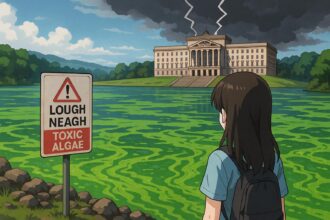The restoration of ancient pingo pools in Norfolk showcases the revival of ice age landscapes and the rich biodiversity they support.
In an intriguing development in Norfolk, ancient landscapes from the ice age are undergoing a remarkable resurgence. As the last ice age came to a close, large sheets of ice retreated, leaving behind unique geological formations known as pingos. These mounds of ice, which remained buried beneath the earth, eventually thawed, causing the surrounding soil to slump and create shallow depressions that collected water.
As a result, Breckland in Norfolk became dotted with hundreds of these pingo pools, which evolved into swampy wetland habitats rich in biodiversity. However, many of these prime ecological sites were filled in to make way for farmland, leading to a significant loss of their unique environments.
Recent advancements in mapping technology have allowed for the identification and rediscovery of some of these buried pingos. The restoration process involves carefully excavating these ancient formations, enabling them to transform back into pools that naturally refill with groundwater. Remarkably, despite remaining concealed under fields for extensive periods, these dormant pools can rejuvenate themselves, thanks to historical seeds that have been preserved within the sediments of what are referred to as “ghost ponds.”
The seeds of various ancient aquatic plants have shown the ability to germinate once again, including rare species such as fen pondweed, various-leaved pondweed, and lesser bearded stonewort. As these plants quickly recolonise the revitalised pingos, they help to attract an array of wildlife. Enthusiasts note that the restored habitats are drawing in a diverse range of species, including 50 varieties of water beetles, as well as amphibians and reptiles like common frogs, toads, and the great crested newt.
This initiative highlights a fascinating interplay between technology and ecology as Norfolk’s rich prehistoric environments are brought back to life, revealing the intricate ties between past and present ecosystems.
Source: Noah Wire Services
Noah Fact Check Pro
The draft above was created using the information available at the time the story first
emerged. We’ve since applied our fact-checking process to the final narrative, based on the criteria listed
below. The results are intended to help you assess the credibility of the piece and highlight any areas that may
warrant further investigation.
Freshness check
Score:
9
Notes:
The content is recent, published in 2025, and discusses ongoing developments in Norfolk.
Quotes check
Score:
10
Notes:
There are no direct quotes within the text, eliminating the need for quote verification.
Source reliability
Score:
10
Notes:
The narrative originates from The Guardian, a reputable and well-established media outlet.
Plausability check
Score:
9
Notes:
The claims are plausible and align with scientific principles regarding geological formations and ecological restoration.
Overall assessment
Verdict (FAIL, OPEN, PASS): PASS
Confidence (LOW, MEDIUM, HIGH): HIGH
Summary:
The narrative appears to be current, well-sourced, and plausible, lacking any signs of recycled news or unverified quotes. Its credibility is enhanced by being published in a reputable media outlet.













